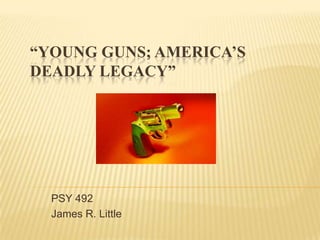
Young Guns Americas Deadly Legacy
- 1. “Young Guns; America’s Deadly Legacy” PSY 492 James R. Little
- 2. Introduction The late black activist Malcolm X infamously stated after the assassination of President John F. Kennedy that “the chickens have come home to roost.” Given the contrasts in their socio-political platforms and Kennedy’s universal appeal this was not a particularly popular statement. I make reference to that statement because in many ways history is repeating itself. As a society that was founded as a result of the American Revolution we’ve come to glorify violence too often and that mind-set has taken root in our children. The most recent report out of the CDC found that on a daily basis a child between the ages of 1-14 is killed in America. In 1994 a staggering 17 young people up to the age of 20 were shot to death …a day. In the following slides I will attempt to shed some light as to perhaps why on this dilemma from a historical perspective.
- 3. Colonial America; the 1700’s Given the necessity of firearms for survival’s sake alone, early colonial laws not only encouraged the ownership of a firearm in every household for survival’s but it became a requirement. Those who could not afford a firearm for any reason were offered what became known as ‘public arms” by the local government for the sake of provision and protection. Of the almost half-million men who participated in the Revolutionary War on the behalf of the colonists roughly 40% were Militiamen. Militiamen and their inherent propensity to “bear arms” returned home and often times continued to “bear arms” and not always against a common enemy. The Revolutionary War brought to the forefront the importance of arms where our position as a sovereign nation was concerned. The capability and right to bear arms collectively and as individual citizens became indispensable.
- 4. The Second Amendment As individual states began to adopt their own laws and statutes where the right to bear arms was concerned the founding fathers recognized the need to adopt a universal standard to address the issue nationally. In 1791 the federal constitution made an amendment to the nationally governing Constitution guaranteeing every law-abiding citizen the right to own a firearm. Originally the amendment was intended to address the individual states’ militias right to bear arms as needed and not individual citizens; even though they made up the militias.
- 5. The Early West; the 1800’s With the advent of gangs and gunslingers in the West and a lack of ample law enforcement, a new code of the West emerged spearheaded by a judge in Ohio. It stated that a citizen who felt in danger of their life no longer had to “take flight” by law and avoid confrontation but could use whatever deadly force was necessary to protect themselves. With the expansion of settlements and railroads into the territories of the indigenous peoples (the American Indians) the Indian Wars ensued and the use of firearms by citizens became widespread. Additionally during this time there were constant disputes over land, cattle and valid/invalid property deeds which led to the Range Wars of the late 1809’s. With the conclusion of the Range Wars in 1893 the Wild West faded and gave way to the 1900’s and the Industrial Revolution and in time Prohibition in which Organized Crime found its birth.
- 6. The 1900’s and Organized Crime The term “organized crime” found its birth in Chicago in 1919 having been conceptualized by a group of local businessmen to promote changes in the criminal justice system in order to better cope with the crime problem. The “criminal class” gave way to “gangsters” and “racketeers” who were epitomized most notably by Al Capone. By the 1960’s the concepts of organized crime and the Mafia became one. The 1980’s and 1990’s saw the introduction of non-traditional and international crime. During the course of the last 80 years organized crime has emerged as an integral part of the big-city life and an alternative for a measureable portion of our youth looking to fit in and frustrated with their options in life.
- 7. Solutions and Alternatives The glorification of guns, shooting, and killing as a means of entertainment must be re-examined and put into its proper perspective. This is particularly true where video games, music, and movies are concerned. Bullying must be quantitatively dealt with as it has given rise to children taking guns to school in fear of their safety; most parents are totally unaware of the problem and that their child is in possession of a gun in most cases. Parents must re-emerge as their children’s mentors and role models as it should be as opposed to a local thug or drug dealer. Fathers and mothers must be more aware of what their children our doing with their idle time and show an earnest interest in who their children are and not leave it up to a video game or cell phone.
- 8. Conclusion It remains our responsibility as parents and adults to ensure the qualitative future of our children and that it not be allowed to be cut short by their deadly and misguided fascination with guns. We must demand that our entertainment media be more accountable and responsible along with parents being better informed and proactive. We as a society must find a way through constructive dialogue with our children to resolve the issuer of kids and guns. If not, we’ll again give witness to Malcolm X’s infamous phrase come to life of “the chickens have come home to roost” with far deadlier consequences culturally and otherwise.